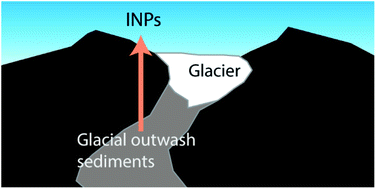Ice nucleating properties of airborne dust from an actively retreating glacier in Yukon, Canada†
Abstract
Airborne dust from glacial outwash sediments may alter properties of clouds and climate at high latitudes by acting as ice nucleating particles (INPs). Nevertheless, the ice nucleating ability of airborne dust from glacial outwash sediments remains uncertain. To address this uncertainty, we measured the ice nucleating ability of airborne dust near an actively retreating glacier in Yukon, Canada during a period when airborne dust concentrations were well above background levels and most likely originated from glacial outwash sediments in the region. The airborne dust caused freezing at temperatures from −6 to −23 °C. Based on a heat assay and an ammonium sulfate assay, the INPs from the airborne dust that caused freezing at temperatures warmer than −15 °C likely contained biological materials. We show that airborne dust from the retreating glacier likely led to high concentrations of ice nucleating particles at the site for at least most of May 2018. These concentrations, at a freezing temperature of −15 °C, were approximately one order of magnitude higher than predictions using a global chemical transport model that included low latitude natural dust sources, but not natural high latitude dust sources.

- This article is part of the themed collection: Atmospheric chemistry in cold environments - Topic Highlight


 Please wait while we load your content...
Please wait while we load your content...